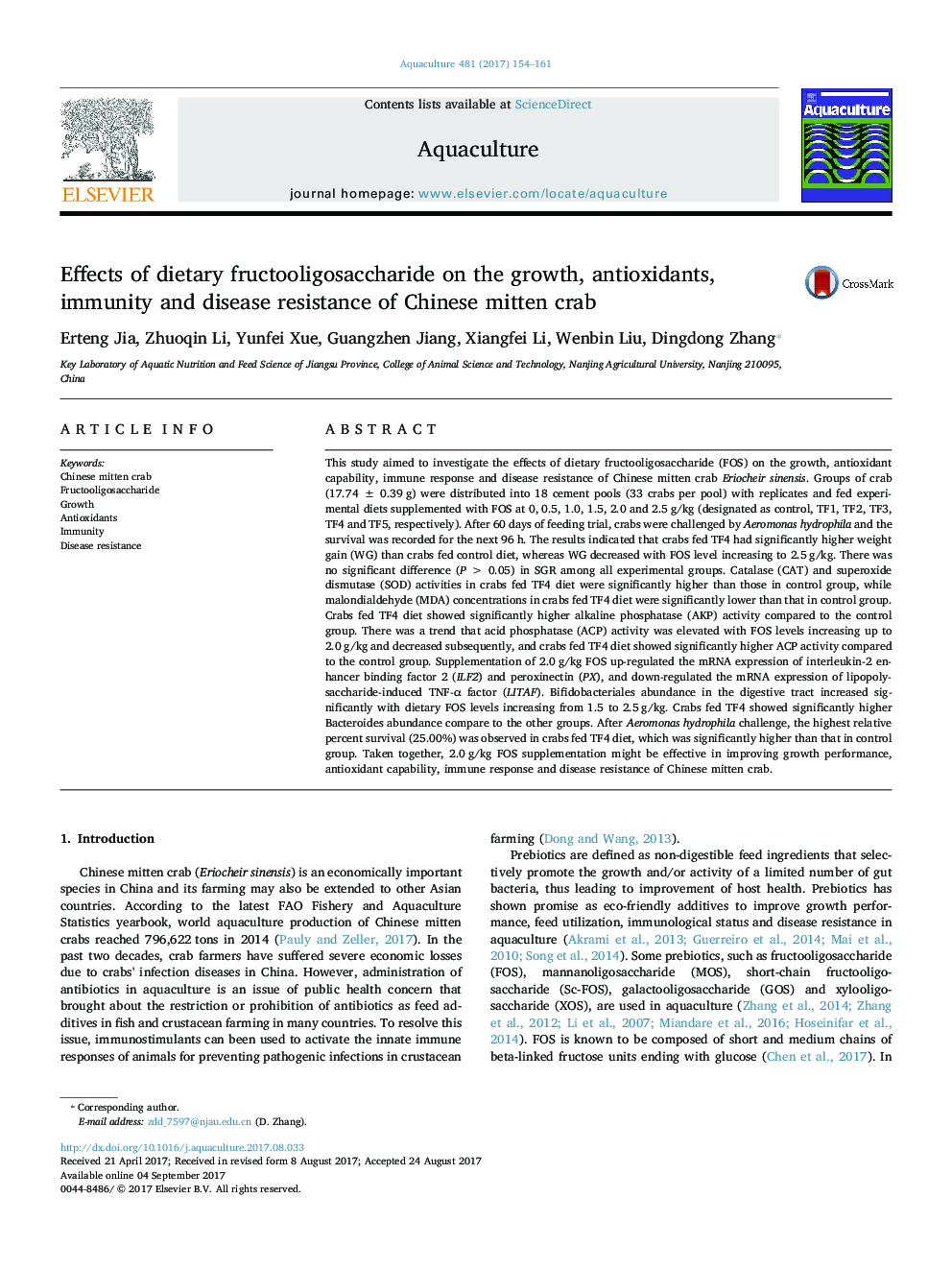| کد مقاله | کد نشریه | سال انتشار | مقاله انگلیسی | نسخه تمام متن |
|---|---|---|---|---|
| 5538958 | 1552807 | 2017 | 8 صفحه PDF | دانلود رایگان |
- The optimal fructooligosaccharide (FOS) level for Eriocheir sinensis was 0.2Â g/kg.
- FOS supplementation significantly affects growth performance, antioxidant capability.
- Crabs fed with 0.2Â g/kg FOS obtained the highest ILF2 and PX expression but the lowest LITAF level.
- The highest survival rates were observed in crabs fed with 0.2Â g/kg FOS, after Aeromonas hydrophila challenge.
This study aimed to investigate the effects of dietary fructooligosaccharide (FOS) on the growth, antioxidant capability, immune response and disease resistance of Chinese mitten crab Eriocheir sinensis. Groups of crab (17.74 ± 0.39 g) were distributed into 18 cement pools (33 crabs per pool) with replicates and fed experimental diets supplemented with FOS at 0, 0.5, 1.0, 1.5, 2.0 and 2.5 g/kg (designated as control, TF1, TF2, TF3, TF4 and TF5, respectively). After 60 days of feeding trial, crabs were challenged by Aeromonas hydrophila and the survival was recorded for the next 96 h. The results indicated that crabs fed TF4 had significantly higher weight gain (WG) than crabs fed control diet, whereas WG decreased with FOS level increasing to 2.5 g/kg. There was no significant difference (P > 0.05) in SGR among all experimental groups. Catalase (CAT) and superoxide dismutase (SOD) activities in crabs fed TF4 diet were significantly higher than those in control group, while malondialdehyde (MDA) concentrations in crabs fed TF4 diet were significantly lower than that in control group. Crabs fed TF4 diet showed significantly higher alkaline phosphatase (AKP) activity compared to the control group. There was a trend that acid phosphatase (ACP) activity was elevated with FOS levels increasing up to 2.0 g/kg and decreased subsequently, and crabs fed TF4 diet showed significantly higher ACP activity compared to the control group. Supplementation of 2.0 g/kg FOS up-regulated the mRNA expression of interleukin-2 enhancer binding factor 2 (ILF2) and peroxinectin (PX), and down-regulated the mRNA expression of lipopolysaccharide-induced TNF-α factor (LITAF). Bifidobacteriales abundance in the digestive tract increased significantly with dietary FOS levels increasing from 1.5 to 2.5 g/kg. Crabs fed TF4 showed significantly higher Bacteroides abundance compare to the other groups. After Aeromonas hydrophila challenge, the highest relative percent survival (25.00%) was observed in crabs fed TF4 diet, which was significantly higher than that in control group. Taken together, 2.0 g/kg FOS supplementation might be effective in improving growth performance, antioxidant capability, immune response and disease resistance of Chinese mitten crab.
Journal: Aquaculture - Volume 481, 1 December 2017, Pages 154-161
